Cyber threats are becoming more advanced, and businesses need AI tools to protect against them. Here's a quick look at the top AI security providers and what they offer:
- 1Point1: Combines IT support with business process automation but lacks advanced threat detection.
- Mindgard: Focuses on securing AI systems against threats like data poisoning and prompt injections.
- Cynet: Simplifies security for SMBs with all-in-one protection but may not scale well for large enterprises.
- Darktrace: Uses self-learning AI for real-time, autonomous threat detection, ideal for fast responses.
- Fortinet: Offers a broad AI-powered security ecosystem, great for large enterprises but complex to deploy.
- Hunters: Automates threat investigation for small security teams but requires fine-tuning.
- Proofpoint: Excels in protecting against phishing and email-based threats but comes at a higher cost.
- Sophos: Affordable endpoint and XDR solutions, best for SMBs but less scalable for larger setups.
- Zscaler: Cloud-native security for distributed teams, though initial setup can be challenging.
- Cisco: Integrates well with existing Cisco systems, offering strong enterprise solutions.
- Gigamon: Provides deep network visibility, including encrypted traffic analysis, but requires expertise.
- Prompt Security: Specializes in protecting generative AI models but has a narrow focus.
Key Takeaways:
- SMBs: Cynet and Sophos are budget-friendly and easy to use.
- Large Enterprises: Fortinet, Cisco, and Darktrace offer advanced, scalable solutions.
- AI-Specific Needs: Mindgard and Prompt Security address vulnerabilities unique to AI systems.
- Cloud-First Organizations: Zscaler is the best choice for remote and hybrid workforces.
Quick Comparison:
| Provider | Best For | Key Strength | Limitation |
|---|---|---|---|
| 1Point1 | IT support + business tools | Unified platform | Lacks advanced threat detection |
| Mindgard | AI model security | AI-specific threat protection | Narrow focus |
| Cynet | SMBs | All-in-one security | Limited scalability |
| Darktrace | Real-time detection | Autonomous responses | High cost, skilled setup needed |
| Fortinet | Large enterprises | Integrated security ecosystem | Complex deployment |
| Hunters | Small security teams | Automates threat investigation | Requires fine-tuning |
| Proofpoint | Email threat protection | Phishing and BEC defense | Higher cost |
| Sophos | SMBs | Endpoint and XDR solutions | Less scalable for large setups |
| Zscaler | Cloud-first organizations | Zero Trust Exchange | Challenging initial setup |
| Cisco | Enterprise networks | Unified, scalable solutions | High cost, steep learning curve |
| Gigamon | Network visibility | Encrypted traffic analysis | Requires expertise |
| Prompt Security | Generative AI protection | AI-specific threat detection | Narrow focus |
Choosing the right provider depends on your organization's size, security needs, and budget.
AI in Cybersecurity: How Companies Can Stay Ahead of Evolving Threats
1. 1Point1

1Point1 weaves cybersecurity into its AI-driven business process platform, seamlessly combining IT support, digital transformation, and trust & safety services. Founded by Akshay Chhabra, the company focuses on optimizing business processes across various industries through AI.
AI Security Features
Security is a core part of 1Point1's process management platform. Its AI-powered IT support services help automate incident response workflows, simplify ticket resolution, and proactively spot potential security issues within IT systems.
The platform also automates IT support tasks while integrating digital risk management features like content moderation, fraud detection, and compliance monitoring. These capabilities enable quicker responses to incidents and ensure consistent security practices, delivering measurable benefits across industries.
Industry Applications
1Point1's platform is versatile, serving a range of industries:
- Finance and Accounting: Handles compliance monitoring, anomaly detection, and risk management to ensure regulatory standards are met.
- E-commerce: Combines supply chain optimization with fraud detection to maintain operational efficiency and protect against threats.
- Healthcare: Offers litigation support to safeguard data privacy and meet strict regulatory requirements.
- Digital Platforms: Provides trust and safety services, including robust content moderation and user protection.
Advantages/Disadvantages
Here’s a snapshot of what 1Point1 offers:
| Aspect | Details |
|---|---|
| Advantages | Integrates business processes, automates tasks cost-effectively, and applies AI across multiple domains |
| Disadvantages | Lacks advanced threat detection and fully autonomous incident response capabilities |
1Point1 shines in its ability to integrate business operations, with security enhancements naturally emerging from its automation and optimization features. For organizations looking for a unified platform that combines IT support with other business functions, 1Point1 could be a strong fit.
However, businesses with more complex security needs - like advanced threat detection or autonomous incident response - might require additional, specialized cybersecurity tools. While 1Point1 boosts security as part of its broader platform, it’s best suited as a complement to dedicated security solutions for organizations with extensive IT infrastructure.
2. Mindgard

Mindgard sets itself apart by focusing exclusively on securing AI systems, tackling vulnerabilities that traditional IT security often misses. Founded in 2022 at Lancaster University and now headquartered in London, the company leverages over a decade of research to address gaps in AI security that conventional tools fail to cover.
AI Security Features
Mindgard's Offensive Security platform brings autonomous red teaming and continuous security testing to the table, specifically designed for AI models. It identifies and mitigates threats unique to AI, such as prompt injections, model inversion, data poisoning, and evasion attacks. At the core of this platform is the CORA AI engine, which automates tasks like anomaly detection, adaptive multi-factor authentication (MFA), and real-time policy recommendations based on user behavior. The platform integrates seamlessly into AI development pipelines through CI/CD compatibility, significantly speeding up security assessments. Additionally, its alignment with the MITRE ATLAS™ framework ensures it covers a wide range of known AI-specific attack vectors.
These features allow organizations to protect sensitive AI deployments with minimal manual effort.
Industry Applications
Mindgard's platform is a game-changer for industries deploying AI in regulated or high-risk sectors. Financial services use it to secure large language models and prevent sensitive data leaks in customer-facing tools. Healthcare providers rely on it to safeguard patient data and ensure diagnostic accuracy. Government agencies and tech companies also turn to Mindgard to meet evolving AI security standards and continuously test their AI systems for vulnerabilities.
Advantages and Disadvantages
| Aspect | Details |
|---|---|
| Advantages | Specifically designed for AI model protection, automated red teaming, real-time threat detection, alignment with MITRE ATLAS™ |
| Disadvantages | No transparent public pricing, requires integration and staff training, may be overkill for smaller AI deployments |
Mindgard shines in identifying and addressing vulnerabilities unique to AI systems, offering automated tools that reduce the burden of manual testing while delivering fast insights and solutions. However, organizations should be prepared for the effort required to integrate the platform and train staff, especially if their AI setups are highly customized or limited in scale.
3. Cynet
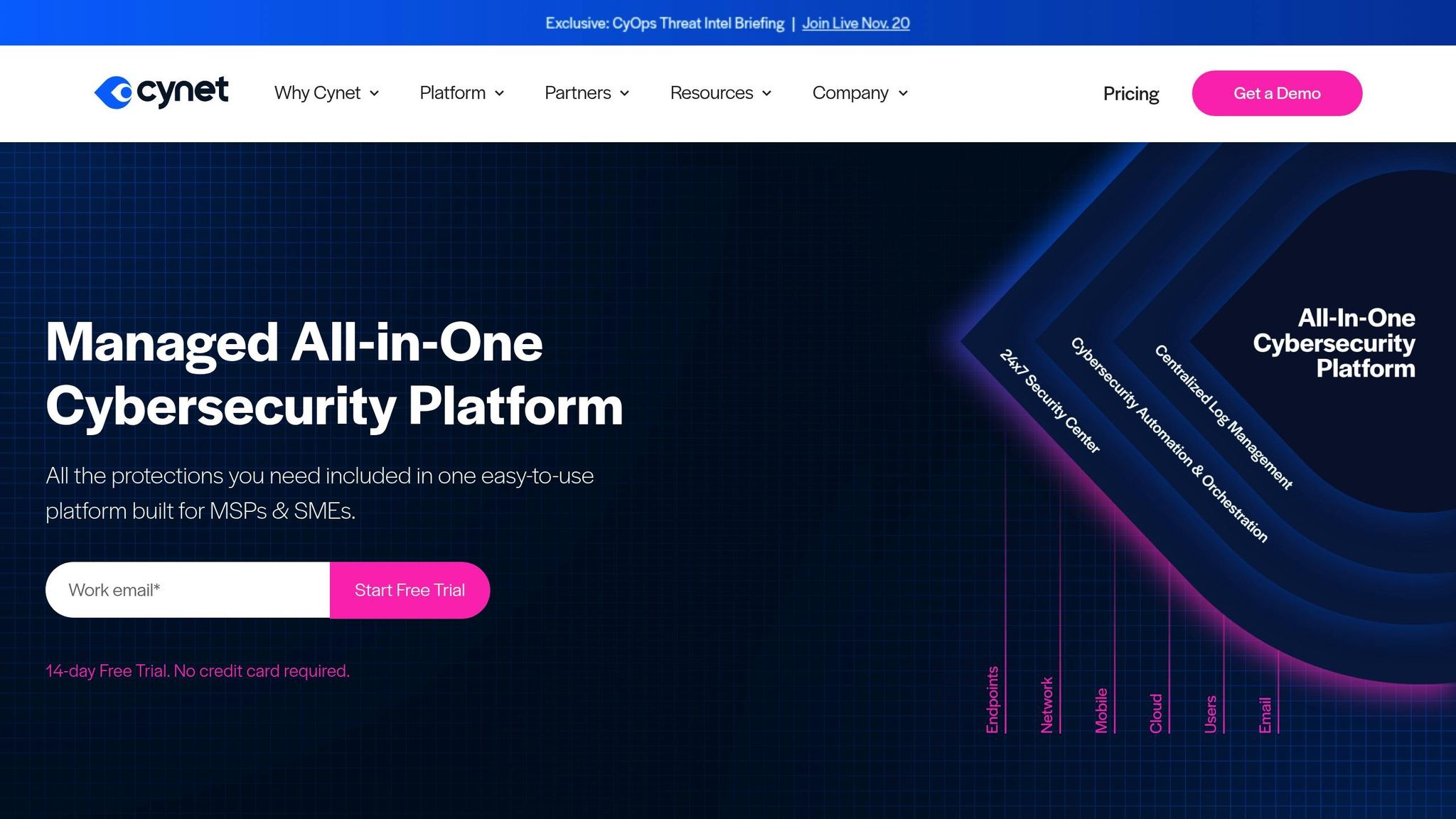
Cynet provides a cybersecurity platform designed to consolidate multiple security functions into one streamlined solution. Based in Boston, Cynet primarily serves SMBs and MSPs, offering enterprise-grade protection without the hassle of juggling numerous tools.
AI Security Features
Cynet's platform highlights the growing trend of simplifying security for smaller organizations by integrating multiple tools into a single system. At its core is Cynet's AI engine, CyAI, which analyzes millions of samples to assess executable files across endpoints. This AI-driven system identifies both known malware and elusive zero-day threats.
The platform combines several key features: endpoint detection and response (EDR), network analytics, user behavior analytics, deception technology, and automated remediation. CyAI continuously scans for advanced threats like ransomware, fileless attacks, and lateral movement within networks. When a threat is detected, it automatically launches response protocols. Cynet’s deception technology sets up decoys to catch lateral attackers, while user behavior analytics pinpoint insider threats by flagging unusual activity.
Pricing (USD)
Cynet uses a subscription-based pricing model tailored to the size and needs of each organization. It offers a bundled package that includes endpoint, network, and user protection, with optional managed detection and response (MDR) services available for an extra fee. Pricing depends on factors like user count and infrastructure requirements, making it a budget-friendly option for SMBs and MSPs.
Industry Applications
Cynet's platform is widely used in industries like healthcare, finance, legal, education, and retail - sectors where strong cybersecurity is critical but in-house security resources may be limited. Healthcare providers rely on Cynet to safeguard patient data and meet HIPAA standards, while financial institutions use it to secure transactions and sensitive records. Educational organizations benefit from its automated ransomware defenses. Its ease of deployment and automated features make it an excellent fit for teams with limited cybersecurity expertise.
Advantages and Disadvantages
| Aspect | Details |
|---|---|
| Advantages | Comprehensive protection for endpoints, networks, and users; automated threat investigation and response; user-friendly dashboard; affordable for SMBs; 24/7 MDR service available |
| Disadvantages | Limited customization for large enterprises; less scalability for complex global infrastructures; may require additional tools for niche security needs |
Cynet shines in providing enterprise-level security in a simple, automated format, making it ideal for smaller organizations. However, large enterprises with intricate, global setups might find its customization and advanced features less robust compared to specialized solutions tailored for bigger infrastructures.
4. Darktrace
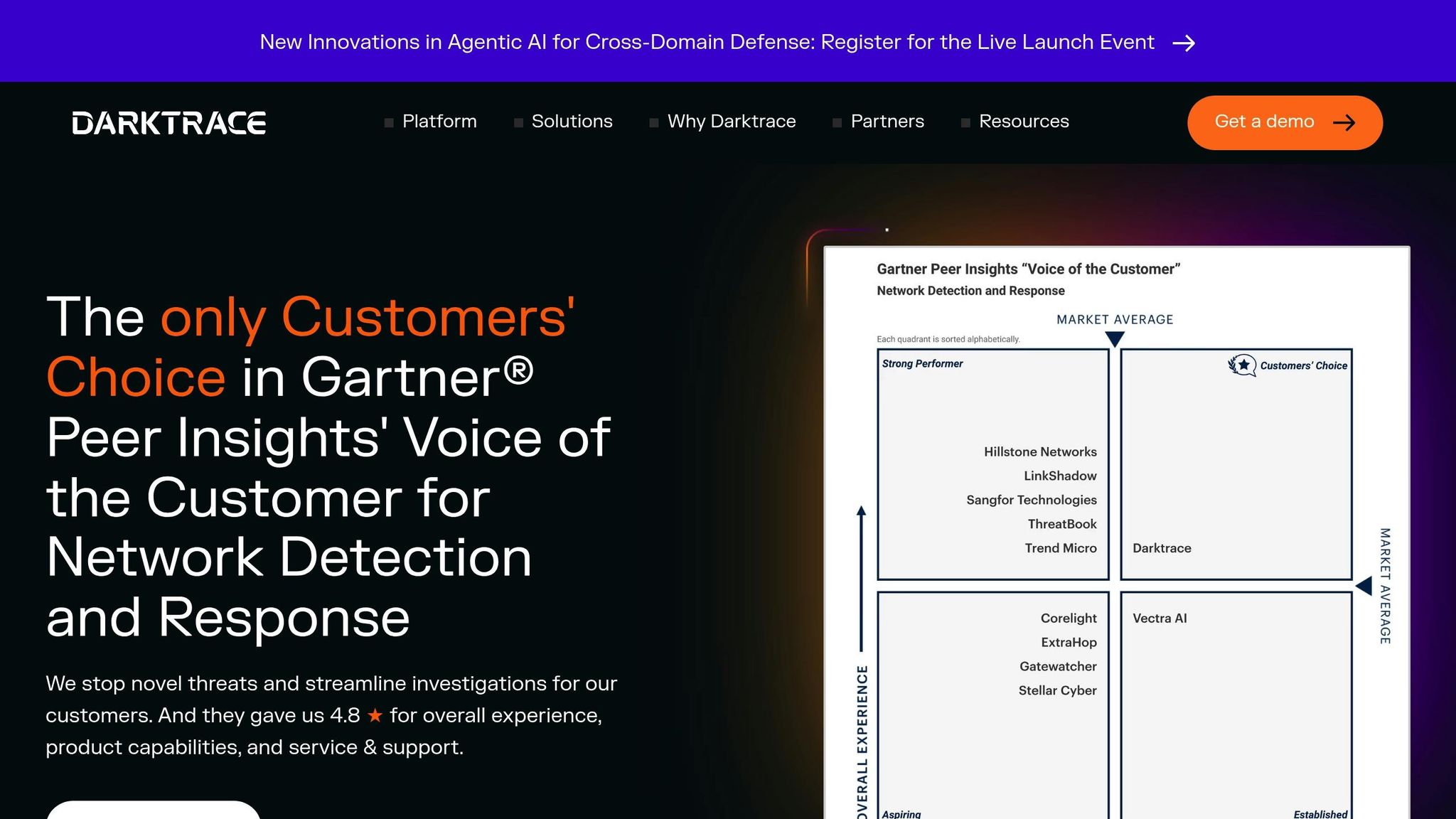
Darktrace, founded in 2013 and headquartered in the UK, has become a prominent name in AI-driven cybersecurity. Its standout feature is the "Enterprise Immune System", an AI model inspired by how the human immune system detects and counters threats.
AI Security Features
What sets Darktrace apart is its self-learning AI, which uses unsupervised machine learning to understand what "normal" looks like in your network. Unlike traditional security tools that depend on predefined rules or known threat signatures, Darktrace's AI processes billions of data points to create a baseline for typical network behavior. Its Cyber AI Analyst streamlines threat investigation and triage, cutting down the workload for security teams by delivering actionable insights on anomalies detected.
When a threat arises, Darktrace can act autonomously through its Antigena module. This feature takes real-time actions - like isolating compromised devices, blocking harmful traffic, or limiting user access - often within seconds of identifying an issue.
Pricing (USD)
Darktrace offers custom-quoted pricing, typically ranging from $30,000 to over $100,000 annually for mid-sized enterprises. Larger deployments come with higher costs.
Industry Applications
Darktrace has made a mark in industries where quick threat detection and autonomous responses are critical. By 2024, it serves over 8,800 customers globally.
In healthcare, for instance, Darktrace has been used to safeguard patient data and critical systems from ransomware. In one case, it detected a ransomware attack, autonomously isolated the affected devices, and prevented data loss, reducing incident resolution time by more than 30%. Financial institutions rely on Darktrace to secure transactions and detect insider threats, while manufacturing companies use it to protect both IT networks and operational technology (OT) systems. Its ability to operate across cloud, on-premises, and hybrid setups makes it a go-to solution for both multinational companies and growing startups.
Advantages and Disadvantages
| Aspect | Details |
|---|---|
| Advantages | Real-time, autonomous threat detection and response; adapts to emerging threats; minimal false positives; effective against zero-day exploits; shortens incident resolution times; compatible with diverse IT environments. |
| Disadvantages | High cost, especially for smaller organizations; requires a training period for optimal performance; risks of unintended disruptions if autonomous responses are misconfigured; challenges in integrating with older systems. |
Darktrace shines in scenarios where rapid, independent threat response is critical, particularly when traditional, signature-based security measures fall short. However, businesses should weigh the initial investment and ensure proper configuration to avoid potential disruptions. Its self-learning capability is especially valuable for uncovering sophisticated, previously unseen threats.
5. Fortinet
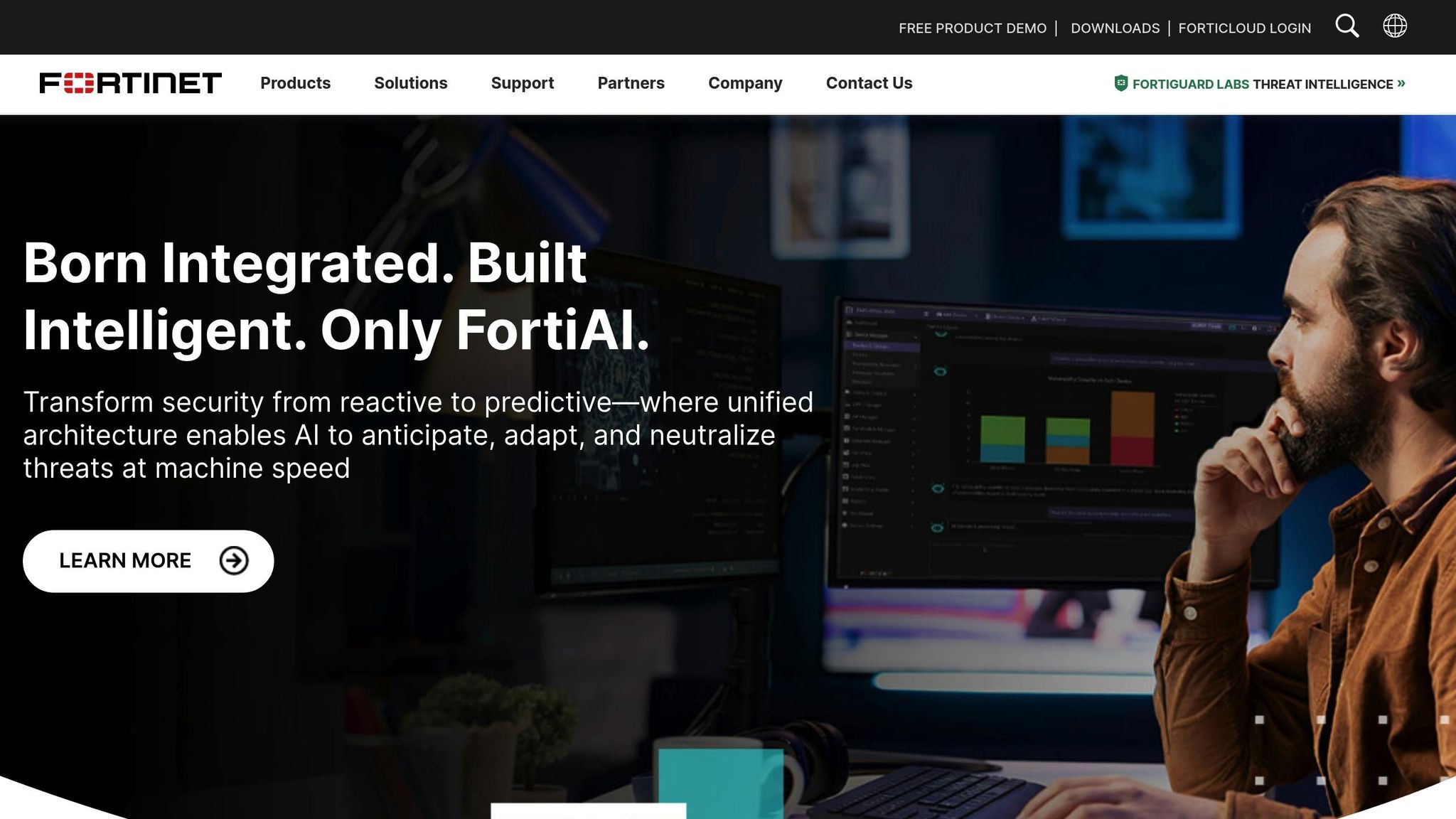
Fortinet has been a pioneer in AI-driven security solutions, with over 15 years of research and more than 500 AI-related patents under its belt. Its extensive ecosystem integrates AI across its entire product line, catering to over 500,000 organizations worldwide, including Fortune 500 companies and government agencies.
AI Security Features
At the heart of Fortinet's AI capabilities is its FortiAI engine, which uses machine learning to detect advanced threats by analyzing network traffic, endpoint activities, and system logs. This engine works seamlessly with other products like FortiGate firewalls and FortiSandbox to deliver a unified threat response [3,6].
Fortinet's FortiGuard Labs plays a crucial role in its strategy, acting as a global threat intelligence network that processes billions of security events daily to provide real-time insights. This continuous sharing of threat intelligence across Fortinet's ecosystem ensures automated, coordinated responses that enhance detection accuracy while reducing false positives.
Unlike traditional systems that rely on static signatures, Fortinet's AI-powered approach is proactive, identifying and addressing emerging threats. This strategy is particularly effective for handling sophisticated attacks while simplifying operations for organizations with complex, distributed IT environments [3,5].
Pricing (USD)
Fortinet offers a subscription-based pricing model in the United States, with costs varying based on the products, deployment scale, and features required. Enterprises with larger infrastructures often face higher costs due to the need for broader coverage and integration. In addition to subscriptions, Fortinet provides perpetual licenses, though additional fees may apply for advanced threat intelligence or managed services. For precise pricing, organizations can request customized quotes.
These flexible pricing options align with Fortinet's scalable, integrated security ecosystem.
Industry Applications
Fortinet's mature AI ecosystem is widely used across industries that demand strong protection against advanced threats and compliance with strict regulations [3,5]. Key sectors include finance, healthcare, government, education, and retail.
For instance, in 2023, a multinational corporation deployed Fortinet's FortiAI and FortiGate firewalls globally. The results? A 30% reduction in security incidents, a 25% boost in threat detection speed, a 20% cut in operational costs, and a 15% improvement in overall security posture.
- Finance: Protects multi-site infrastructures and ensures secure transactions.
- Healthcare: Safeguards sensitive patient data across distributed networks.
- Education: Enables secure remote learning environments.
- Retail: Defends customer data and payment systems from breaches.
Advantages and Disadvantages
| Aspect | Details |
|---|---|
| Advantages | Real-time threat intelligence across products; Automated detection and response; Simplifies operations for complex IT setups; High accuracy in detecting advanced threats; Scalable for various organizational sizes; Backed by extensive AI research and patents |
| Disadvantages | Initial deployment can be challenging in legacy environments; Requires skilled personnel to utilize advanced features; High subscription costs for larger deployments; Learning curve for teams transitioning from traditional systems |
Fortinet's ecosystem is designed to enhance security through seamless integration and real-time intelligence sharing. While the platform offers impressive benefits, organizations should anticipate a complex setup process and ensure they have the expertise to unlock its full potential.
6. Hunters
Hunters stands out in the AI security landscape with its next-generation Security Information and Event Management (SIEM) platform, designed specifically for lean security teams. What sets Hunters apart is its focus on autonomous investigation capabilities, which help teams cut through the noise of endless alerts and zero in on genuine threats. This approach is the backbone of its AI-driven features.
AI Security Features
At the heart of Hunters' platform is Pathfinder AI, which uses specialized agents to autonomously analyze data from network traffic, cloud environments, identities, and endpoints. This creates a comprehensive security overview.
What makes Hunters powerful is its ability to automatically investigate and correlate threats. Unlike traditional SIEM systems that rely on manual processes and rule-based detection, Hunters employs machine learning to sift through security telemetry and identify suspicious patterns. Its AI agents work together to create detailed attack narratives, offering full context for incidents. This not only reduces alert fatigue but also speeds up threat triage, giving security teams a clearer picture of attacks and enabling faster, more effective responses.
The platform excels at correlating signals from various data sources, pinpointing unusual behavior, and streamlining investigations with automation. For example, in a large financial institution, Hunters successfully correlated data from endpoints, networks, and cloud systems to detect a sophisticated phishing attack. The result? Incident response time dropped from several days to under an hour, effectively preventing data theft.
Pricing (USD)
Hunters uses a subscription-based pricing model, with costs determined by the amount of data ingested (measured in gigabytes per day) and the number of protected assets. Pricing usually starts in the low tens of thousands of dollars annually for mid-sized enterprises. However, exact costs depend on the scale of deployment and specific needs. Organizations are encouraged to request a customized quote to get a clear understanding of pricing based on their data and infrastructure requirements.
Industry Applications
Hunters is particularly well-suited for industries with stringent security and compliance demands, such as financial services, healthcare, technology, and critical infrastructure. It shines in environments where large volumes of security data need to be processed by small, resource-constrained teams. Common use cases include:
- Automated detection of advanced persistent threats
- Quick investigation of ransomware attacks
- Continuous monitoring of cloud environments for suspicious activity
Organizations operating in complex multi-cloud or hybrid IT setups benefit greatly from Hunters' ability to correlate data across different domains.
Advantages and Disadvantages
| Aspect | Details |
|---|---|
| Advantages | Reduces alert fatigue with automated correlation; detects advanced threats more effectively; integrates seamlessly with other tools; provides detailed attack narratives; ideal for small, resource-limited SOCs |
| Disadvantages | Requires initial setup and tuning for specific environments; risk of false positives if data sources are incomplete; advanced features may need additional training; relies on the quality of integrated data |
Hunters has earned praise from industry analysts for its use of AI in security operations, particularly for reducing the time it takes to detect and respond to threats. Its open architecture allows smooth integration with existing tools like SIEM systems, EDR solutions, cloud platforms, and network monitoring tools. This flexibility means organizations can enhance their current setups while gaining advanced AI-driven capabilities.
7. Proofpoint
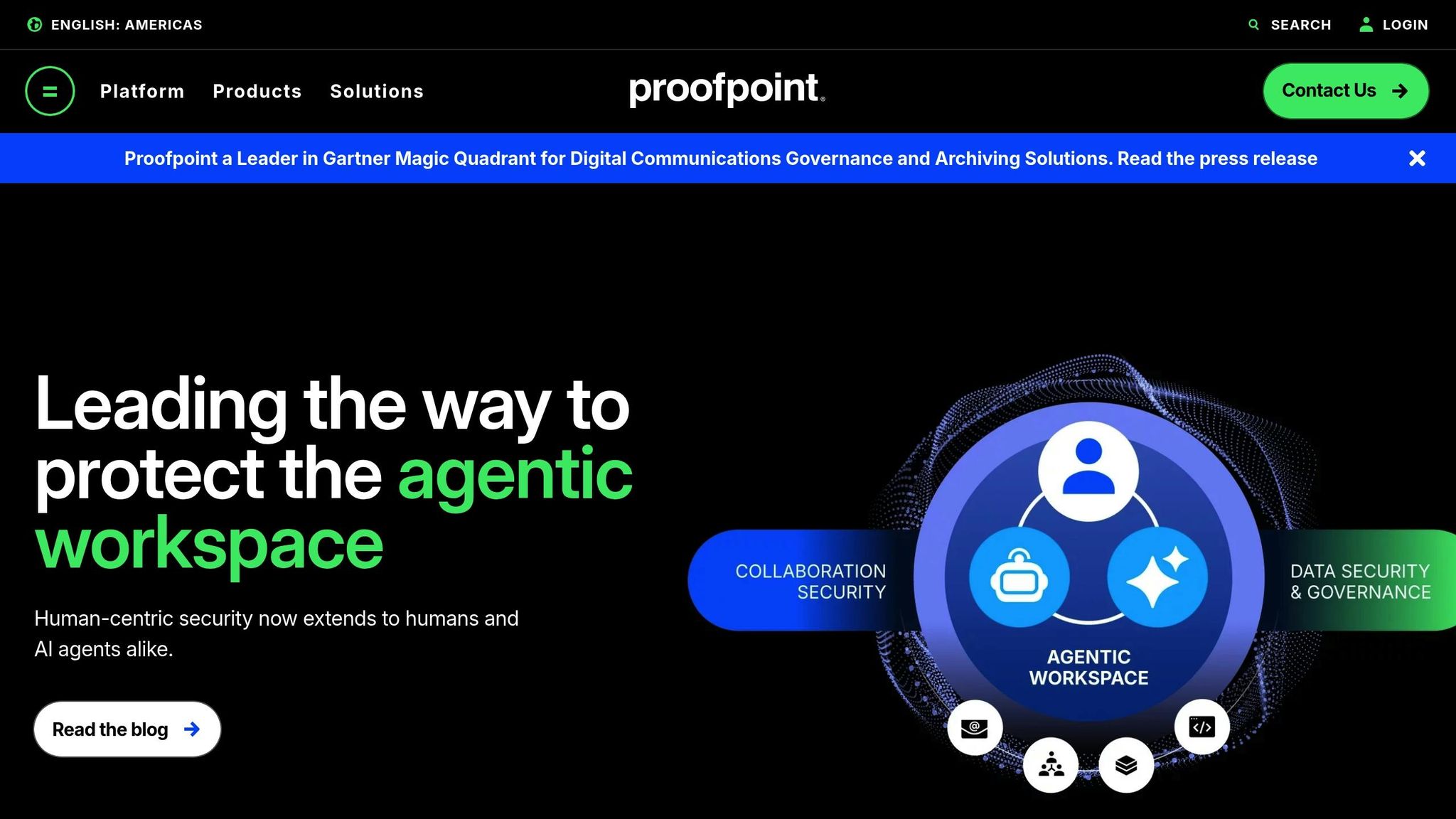
Proofpoint takes a unique approach to cybersecurity by focusing on people rather than just systems or networks. While many security providers emphasize protecting infrastructure or endpoints, Proofpoint zeroes in on the human element, recognizing that people are often the most vulnerable link in the security chain. Their AI-powered platform is designed to combat threats like phishing, business email compromise (BEC), and social engineering, which specifically target individuals.
AI Security Features
At the heart of Proofpoint's platform is NexusAI, an advanced engine that processes over 100 billion data points every day. Using machine learning and deep learning techniques, NexusAI analyzes email metadata, sender behavior, and message content in real time. This allows it to identify threats ranging from malicious code to subtle anomalies like impersonation attempts or unusual account activity. What sets it apart is its ability to adapt to new attack methods, making it particularly effective against evolving phishing and BEC tactics. To further strengthen defenses, the platform includes user training and awareness modules, helping employees recognize and resist social engineering attempts.
Pricing (USD)
Proofpoint operates on a subscription-based pricing model. Costs vary depending on factors like the number of users, selected security features, and the size of the organization. Basic email protection starts at just a few dollars per user per month, while more comprehensive enterprise-level solutions are priced higher. Organizations typically need to request a custom quote tailored to their specific needs and deployment scale.
Industry Applications
Proofpoint's people-centric focus makes it particularly valuable in industries where human-targeted threats pose significant risks:
- Financial Services: Protects against wire fraud and BEC schemes.
- Healthcare: Safeguards sensitive patient data from phishing attacks that could lead to regulatory breaches.
- Government and Education: Provides email and communication security to prevent data loss and ensure compliance.
- Retail: Shields customer and transaction data from cyber threats.
Advantages and Disadvantages
| Aspect | Details |
|---|---|
| Advantages | • Focuses on human-targeted threats • Processes massive volumes of threat data daily • Adapts to emerging attack methods • Includes user training to strengthen defenses • Proven success in combating phishing and BEC attacks |
| Disadvantages | • Occasional false positives may disrupt communication • Integration with older systems can require extra effort • Higher cost compared to basic email security options • Requires training for administrators to maximize effectiveness |
Proofpoint has earned a strong reputation in email security, thanks to its advanced AI capabilities and ability to keep up with ever-changing threats. It’s a trusted choice for organizations that face sophisticated attacks targeting individuals.
However, for businesses seeking a broader, more integrated approach to cybersecurity, 1Point1 offers a compelling alternative. While Proofpoint focuses on email and communication security, 1Point1 combines robust AI-driven security with business process management, IT support, and digital transformation tools. This all-encompassing approach not only addresses security needs but also enhances operational efficiency, making it a smart choice for organizations looking to balance protection with streamlined performance.
sbb-itb-3387f43
8. Sophos

Sophos stands out among security providers with its scalable, AI-powered endpoint and extended detection response (XDR) solutions. It brings enterprise-level AI security to organizations of all sizes, making advanced protection accessible beyond just large corporations.
AI Security Features
Sophos's Intercept X uses deep learning to analyze millions of malware samples, enabling it to detect both known and unknown threats. By evaluating file behavior, code patterns, and system interactions, it effectively counters advanced attacks like zero-day exploits and ransomware.
The Sophos XDR platform takes security a step further by integrating generative AI capabilities. These features automatically correlate threat data across endpoints, servers, firewalls, and cloud environments, giving security teams detailed incident summaries and actionable recommendations. The platform also uses AI-driven behavioral analytics to monitor network activity and user behavior. When it detects anomalies that suggest malicious activity, it can automatically contain threats and alert security teams, proving especially effective against advanced persistent threats and insider risks.
Pricing (USD)
Sophos offers scalable, subscription-based pricing. The Intercept X Advanced plan starts at about $36 per user annually for basic endpoint protection. For organizations needing more advanced features - like those included in the XDR platform - pricing typically ranges between $30 and $60 per user per year, depending on the deployment size and selected features.
This flexible pricing structure makes Sophos a practical choice for businesses across various industries.
Industry Applications
Sophos's AI-driven security solutions are widely used across industries where quick threat detection and regulatory compliance are critical:
- Healthcare: Protects sensitive patient data and ensures HIPAA compliance by detecting unusual access patterns that could indicate breaches.
- Education: Shields student and faculty information from ransomware and phishing attempts.
- Financial Services: Prevents fraud and secures financial data using deep learning capabilities.
- Government: Safeguards critical infrastructure from advanced persistent threats by correlating threat intelligence across multiple layers.
For example, a U.S.-based healthcare provider that adopted Sophos Intercept X with XDR reported a significant drop in phishing and malware incidents. The AI-driven analytics even identified and blocked a previously unknown ransomware variant, preventing what could have been a major data breach.
Advantages and Disadvantages
| Aspect | Details |
|---|---|
| Advantages | - Achieves 99.98% malware detection rates in independent tests - Cuts detection and response times by 50% - User-friendly interface suitable for smaller organizations - Unified XDR platform integrates multiple security layers - Strong protection against zero-day threats and ransomware |
| Disadvantages | - Advanced features may require extra configuration and training - Costs can rise with additional features - Challenges in integrating with older systems - AI performance depends on regular updates and fine-tuning - Some competitors offer broader integrations for large-scale enterprises |
Sophos enjoys strong user ratings, with an average of 4.5 out of 5 stars on platforms like Gartner Peer Insights and G2. Users frequently highlight its detection accuracy, automated responses, and low rate of false positives.
For businesses seeking a fully integrated solution, 1Point1 combines IT support and digital transformation services with top-tier security, offering additional operational benefits alongside Sophos's capabilities.
9. Zscaler
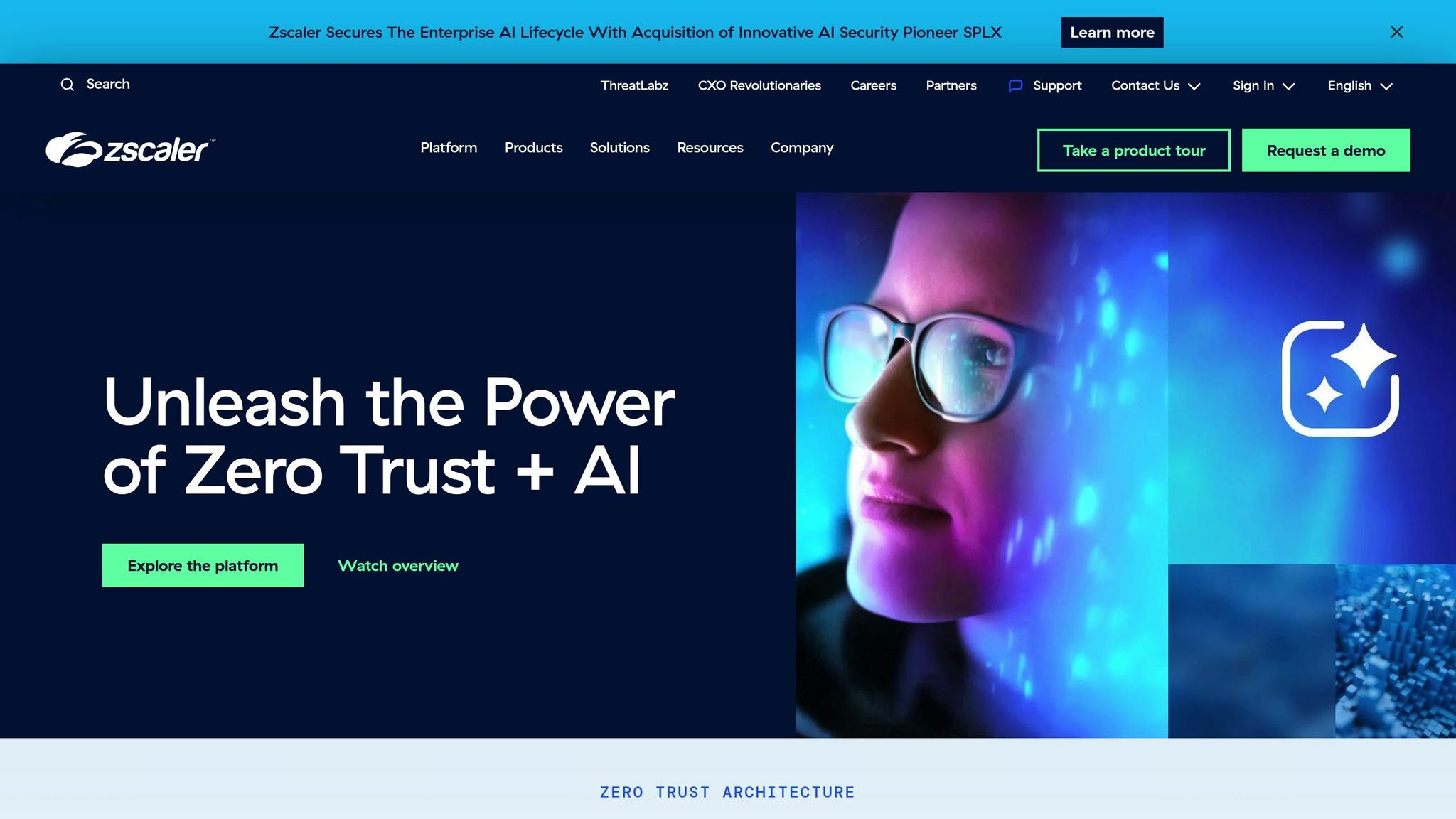
Zscaler takes a cloud-first approach to security, offering a platform that replaces traditional on-premises appliances. Its Zero Trust Exchange directly connects users to applications, significantly reducing the risk of attacks.
AI Security Features
The Zero Trust Exchange manages a staggering 300 billion transactions daily, blocking over 150 million threats every day with the help of advanced machine learning algorithms. These algorithms analyze user behavior, device activity, and application context in real time, making security decisions without human input.
By learning what constitutes normal behavior for users, devices, and applications, Zscaler’s AI models flag anomalies automatically and adapt policies to counter threats. This proactive approach detects sophisticated attacks - like advanced persistent threats and insider risks - that traditional signature-based systems might miss.
Pricing (USD)
Zscaler’s pricing begins at approximately $8–$12 per user per month for its basic secure web gateway services. For organizations needing advanced features, custom quotes are available for higher-tier options.
This subscription-based model eliminates upfront hardware costs and includes ongoing updates, threat intelligence, and customer support. It’s a strong choice for businesses aiming to modernize their security systems without significant capital expenditure.
Industry Applications
With a customer base of over 7,000 organizations globally, Zscaler has proven its value across various industries. For instance, a U.S.-based healthcare provider saw a 60% drop in phishing incidents while ensuring compliance with HIPAA regulations. Financial institutions, government agencies, and manufacturers also rely on Zscaler for its consistent and secure protection across hybrid and remote work environments.
The ability to provide secure, direct access to cloud applications makes Zscaler especially appealing for companies with distributed workforces.
Advantages and Disadvantages
| Aspect | Details |
|---|---|
| Advantages | - Eliminates reliance on on-premises security appliances - Scales effortlessly to support remote and hybrid workforces - Processes over 300 billion daily transactions with AI-driven threat detection - Complies with key standards like FedRAMP, SOC 2, and ISO 27001 - Integrates seamlessly with identity providers and SIEM platforms |
| Disadvantages | - Requires dependable internet connectivity for optimal performance - Initial setup can be complex for large-scale enterprise migrations - Subscription costs may add up for extensive deployments - Limited options for organizations needing strict on-premises data residency - Potential latency issues with certain applications |
Zscaler is frequently recognized as a leader in Gartner’s Magic Quadrant for Security Service Edge and Zero Trust Network Access. Its scalability and strong security capabilities earn high praise, though some users mention challenges during initial enterprise-level setup.
While Zscaler excels in cloud-focused security, organizations seeking integrated IT and business process solutions might find platforms like 1Point1 more aligned with their needs.
10. Cisco

Cisco leverages its decades of networking expertise to deliver AI-powered security solutions that combine advanced threat intelligence with automated responses. As the company connecting all Fortune 100 companies, Cisco utilizes its extensive network foundation to strengthen its security offerings.
AI Security Features
At the center of Cisco's AI security offerings is the SecureX platform, which acts as a unified hub. This platform uses machine learning to link security events across firewalls, endpoint protection systems, and cloud platforms, enabling a coordinated and efficient response. Cisco Talos, the company's threat intelligence team, analyzes vast amounts of global network data to train AI models capable of identifying sophisticated threats that traditional methods might overlook. These analytics continuously adapt by learning from network behavior, detecting anomalies, and adjusting security policies to address insider threats, advanced persistent threats, and zero-day vulnerabilities.
Pricing (USD)
Cisco offers subscription-based pricing for its security solutions, tailored to deployment size and feature requirements:
- Cisco Secure Endpoint: $30–$60 per user annually
- Cisco Umbrella: $2.20–$5.50 per user monthly
- Enterprise firewalls: Starting at several thousand dollars per device, with additional costs for AI-driven threat intelligence and analytics features
Industry Applications
Cisco's integrated security solutions are particularly suited for large enterprises with complex infrastructures spanning multiple locations. For example, a major U.S. healthcare provider utilized Cisco SecureX and AI-driven analytics to cut incident response times by over 50%, successfully block ransomware attempts, and maintain HIPAA compliance. Financial institutions rely on Cisco to handle high transaction volumes while meeting strict regulatory standards. Government agencies benefit from its ability to support both on-premises and cloud operations. Additionally, manufacturers can secure their operational technology networks with Cisco's tools, which differentiate between normal industrial processes and potential cyber threats without disrupting production workflows. This comprehensive approach positions Cisco as a leader in AI-powered network security, standing alongside providers like 1Point1.
Advantages and Disadvantages
| Aspect | Details |
|---|---|
| Advantages | - Integrates seamlessly with existing Cisco networking systems - Access to global threat intelligence via Cisco Talos - Coordinated security responses across tools - Scalable for large enterprises - Strong support for industry compliance requirements |
| Disadvantages | - High total cost of ownership for large-scale setups - Challenging to implement in non-Cisco environments - Steep learning curve for administrators new to Cisco - May require further investment in Cisco's broader ecosystem - Advanced features often tied to enterprise-level agreements |
Cisco is frequently recognized by industry analysts for its leadership in network and endpoint security, thanks to its robust automation and threat intelligence capabilities. Organizations using Cisco's AI-driven tools report up to a 30% reduction in incident resolution times, minimizing the impact of potential cyberattacks.
While Cisco excels in delivering integrated, high-performance network security, enterprises seeking a more comprehensive solution that combines IT security with broader business process management might find 1Point1 to be a better fit. With its AI-driven platform that enhances IT infrastructure while supporting digital transformation and operational efficiency, 1Point1 offers a more expansive solution for businesses aiming to achieve end-to-end excellence.
11. Gigamon
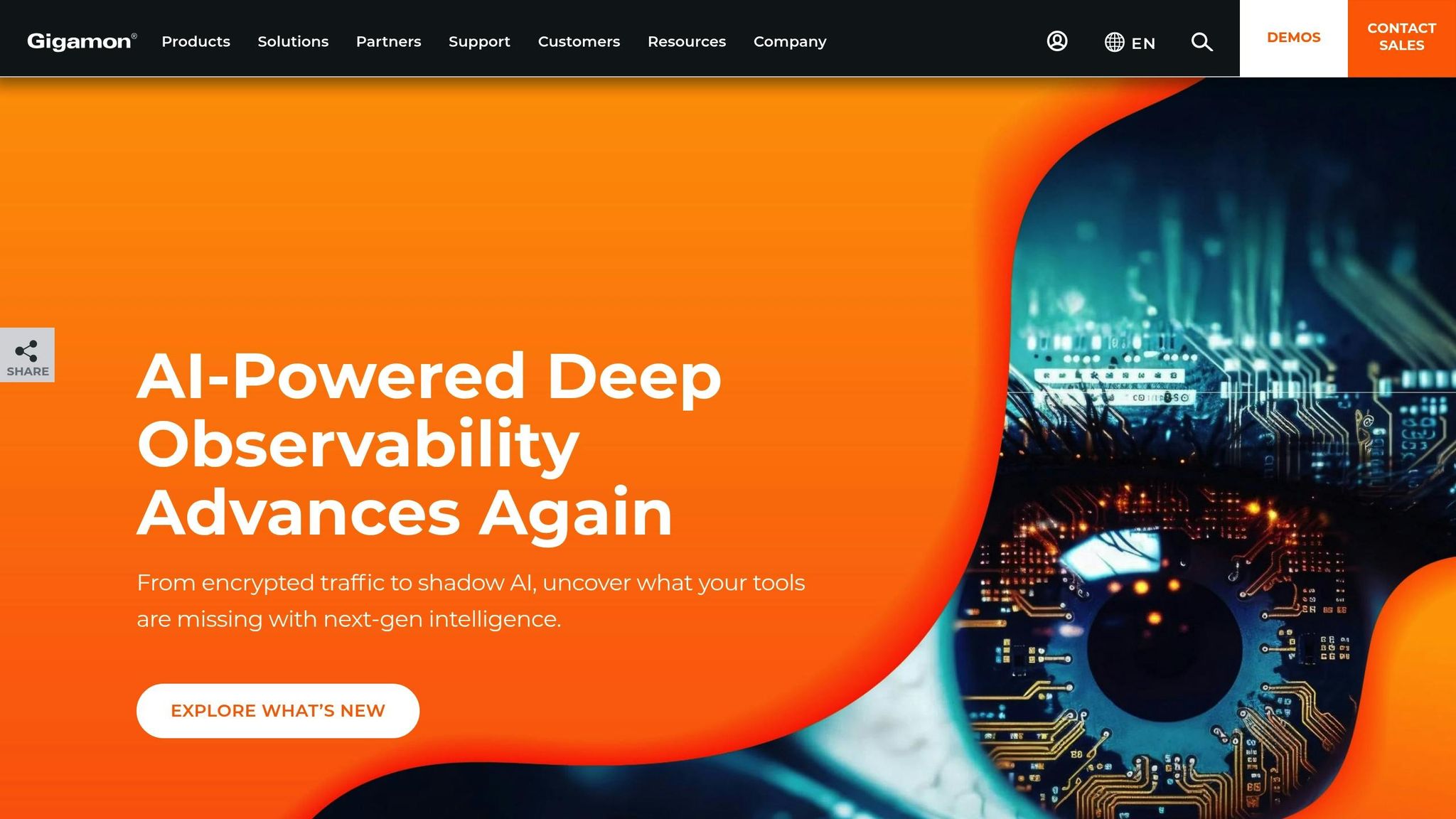
Gigamon plays a key role in the AI security space by focusing on deep network observability. The company provides extensive visibility into network traffic, using AI-driven analytics to identify advanced threats that might evade traditional security tools. This makes it particularly useful for businesses with complex IT infrastructures, including those managing hybrid and multi-cloud environments, where monitoring both encrypted and unencrypted data flows is critical.
AI Security Features
At the heart of Gigamon's security capabilities is its Deep Observability Pipeline. This platform uses machine learning to continuously analyze network traffic, detect anomalies, and identify threats like lateral movement or data exfiltration attempts. A standout feature is its ability to analyze encrypted traffic without requiring decryption, offering security teams valuable insights into suspicious activities. Additionally, Gigamon integrates seamlessly with tools like SIEM, SOAR, and XDR, which simplifies threat detection and response workflows.
Pricing (USD)
Gigamon operates on a custom pricing model, tailored to the specific needs of each deployment. Enterprise implementations typically range from $50,000 to $500,000 annually, with options for subscription-based or perpetual licenses. Discounts for volume purchases and professional setup services are available, though organizations should also account for ongoing support costs. Factors such as network throughput, the number of monitoring points, and integration complexity influence the final pricing, ensuring a customized solution for each client.
Industry Applications
Gigamon’s technology is particularly beneficial for industries with stringent security and compliance demands:
- Financial Services: Helps secure high-frequency trading networks and detect complex fraud attempts while ensuring PCI DSS compliance.
- Healthcare: Provides full network visibility to safeguard patient data and maintain HIPAA compliance. For example, a major U.S. healthcare provider used Gigamon to uncover a previously undetected lateral movement attack by analyzing encrypted traffic across multiple network segments, enabling swift containment.
- Government and Telecommunications: Supports zero trust architectures and protects critical infrastructure by identifying insider threats and advanced persistent threats.
Advantages and Disadvantages
| Aspect | Details |
|---|---|
| Advantages | - Extensive visibility across hybrid environments - AI-driven analytics reduce false positives by up to 50% - Encrypted traffic analysis without decryption - Strong integration with existing tools - Speeds up detection and response times by up to 70% |
| Disadvantages | - Deployment can be challenging in highly segmented networks - Skilled personnel needed for optimal configuration - High initial costs for large-scale setups - Tuning AI models can be time-consuming initially |
Industry experts frequently highlight Gigamon as a leader in network visibility and analytics, praising its use of AI to tackle modern security threats. Many organizations report reduced alert fatigue and faster incident resolution, significantly improving their overall security posture.
While Gigamon shines in network visibility and threat detection, businesses looking for a broader solution might consider 1Point1. Along with robust IT security, 1Point1 offers an integrated platform that supports business process management and digital transformation, helping companies improve operational efficiency while fortifying their security measures.
12. Prompt Security
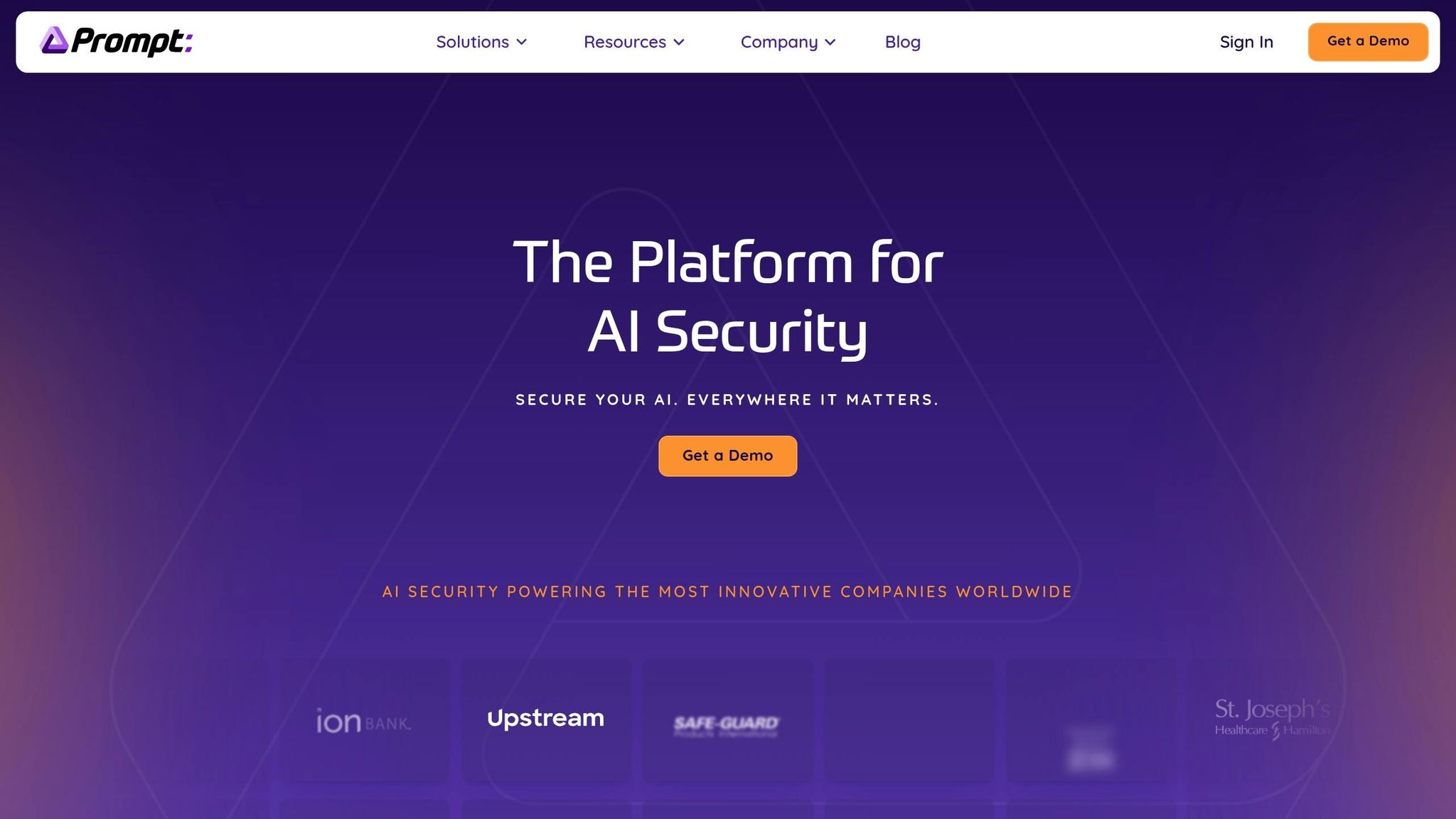
Prompt Security focuses on safeguarding generative AI applications and large language models (LLMs) from specialized threats like prompt injection attacks. As businesses increasingly rely on generative AI, the company addresses vulnerabilities unique to these AI-driven workflows.
AI Security Features
Prompt Security offers real-time protection tailored to generative AI vulnerabilities, including prompt injection, model inversion, and data poisoning. Using automated red teaming methods, the platform continuously tests AI models to uncover weaknesses. It employs adaptive learning and behavioral analytics to detect both known and emerging threats, including zero-day attacks that specifically target AI systems.
One standout feature of Prompt Security is its runtime protection, which integrates directly into development pipelines. This allows organizations to conduct ongoing security testing as they build and refine their AI models, ensuring that defenses keep pace with rapid development cycles. Additionally, the platform monitors AI workflows by analyzing user interactions to spot suspicious activity or attempts to extract sensitive information. This functionality is especially critical for businesses handling confidential or customer data, reinforcing Prompt Security's role in protecting high-stakes AI environments.
Pricing (USD)
Prompt Security operates on a subscription-based pricing model, with costs determined by factors like endpoint count, data volume, and service tier. For U.S. businesses, monthly pricing typically ranges from several hundred to several thousand dollars, depending on the size of the organization and its security needs. Enterprise clients can request custom pricing for large-scale deployments, and many plans include free trials or proof-of-concept options to demonstrate the platform’s value before a full commitment. For organizations, this investment should be weighed against the potential costs of AI-related security breaches, which could involve data theft or regulatory penalties in industries with strict compliance standards.
Industry Applications
Prompt Security’s advanced features make it particularly useful in sectors where data privacy and AI adoption intersect. Financial institutions use the platform to prevent insider threats and data leaks, ensuring compliance with banking regulations. Healthcare providers rely on it to protect sensitive patient information processed by AI models while maintaining HIPAA compliance.
For example, a mid-sized U.S. healthcare provider deployed Prompt Security to detect suspicious access patterns during a credential-stuffing attack. The platform automatically triggered multi-factor authentication and isolated affected endpoints, successfully preventing unauthorized access to patient records. This case highlights its effectiveness in securing generative AI systems.
E-commerce businesses benefit from real-time fraud detection and automated responses to account takeover attempts, reducing both financial losses and reputational harm. Similarly, technology companies developing AI products use Prompt Security to secure their models throughout the development process.
Advantages and Disadvantages
| Aspect | Details |
|---|---|
| Advantages | - Focused on AI-specific threats like prompt injection - Automated red teaming ensures constant vulnerability assessment - Seamless integration with development pipelines - Real-time threat detection and automated incident response - Cuts incident resolution times by around 30% |
| Disadvantages | - Initial setup can be challenging for organizations with limited IT support - False positives during the platform's learning phase may require manual adjustments - Higher costs compared to standard security tools - Requires continuous cloud connectivity |
Industry experts have praised Prompt Security for its focus on addressing AI-specific threats, a growing concern as generative AI continues to expand in enterprise settings. The platform aligns with frameworks like MITRE ATLAS™, which is designed to identify and mitigate AI-related risks.
While Prompt Security excels in protecting generative AI systems, businesses seeking broader operational improvements might explore alternatives like 1Point1, which combines IT security with tools for digital transformation. For organizations aiming to enhance both security and overall business processes, 1Point1’s integrated approach could be worth considering.
Provider Comparison
Choosing the right AI security provider depends on your organization's size, compliance requirements, and technical expertise. Here's a breakdown of key differences to help you make an informed decision.
When it comes to scalability, providers like Darktrace and Zscaler stand out with their cloud-native, AI-driven automation, making them ideal for global, large-scale deployments. On the other hand, Cisco and Fortinet deliver scalable solutions through integrated security frameworks, which are well-suited for large, multi-site enterprises. Meanwhile, Cynet and Hunters focus more on small to mid-sized businesses, which may limit their ability to meet the needs of very large organizations.
Compliance is a critical factor for regulated industries. Providers such as Proofpoint, Fortinet, and Cisco offer built-in tools for meeting standards like HIPAA, GDPR, and PCI DSS. Darktrace and Zscaler emphasize features such as data residency controls and detailed audit trails. Specialized vendors like Mindgard and Prompt Security address AI-specific risks but may need to be paired with broader compliance frameworks.
Integration capabilities are another important consideration. Providers like Cisco, Fortinet, and Sophos excel in this area with extensive API support. Cloud-native platforms such as Darktrace and Zscaler perform particularly well in hybrid environments. However, vendors like Mindgard and Hunters may require more specialized setups, especially for securing AI models and enabling advanced threat hunting.
| Provider | Scalability | Compliance Support | Integration Ease | Best For | Primary Limitation |
|---|---|---|---|---|---|
| 1Point1 | Moderate | Moderate | High | Business process management with IT support | Not a dedicated IT security provider |
| Mindgard | High (AI-specific) | High (MITRE ATLAS™) | High | AI/ML model security | Limited to AI-specific threats |
| Cynet | Moderate | Moderate | High | SMBs and MSPs | May lack advanced features for large enterprises |
| Darktrace | High | Moderate | Moderate | Real-time autonomous detection | Requires skilled personnel for optimal deployment |
| Fortinet | High | High | Low | Large multi-site enterprises | Complex integration process |
| Hunters | High | Moderate | Moderate | SOC automation | Focused primarily on threat hunting |
| Proofpoint | High | High | Moderate | Human-targeted attack defense | Higher investment required |
| Sophos | Moderate | Moderate | High | SMBs and endpoint security | Limited scalability for very large organizations |
| Zscaler | High | High | Moderate | Cloud-first distributed organizations | Significant investment needed |
| Cisco | High | High | Low | Large enterprises with hybrid cloud | Complex deployment requirements |
| Gigamon | High | Moderate | Low | Network-centric security | Requires network expertise |
| Prompt Security | Moderate | Moderate | High | Generative AI protection | Narrow focus on AI applications |
Beyond scalability and compliance, cost and AI automation are also major factors. Pricing models vary: Darktrace, Zscaler, and Proofpoint offer per-user or per-device subscription plans. Cisco and Fortinet provide both subscription and perpetual licensing options, while Cynet and Sophos are known for cost-effective, all-in-one solutions tailored for SMBs.
AI automation is where many of these platforms shine. For example, Darktrace uses its Enterprise Immune System to mimic human immune responses, enabling adaptive threat detection without relying on predefined rules. Mindgard aligns with the MITRE ATLAS™ framework, offering automated red teaming for AI models. Similarly, Proofpoint employs deep learning to analyze vast datasets and detect phishing and business email compromise attempts.
Organizations leveraging AI security tools have reported up to a 30% reduction in incident resolution times, significantly reducing the impact of cyberattacks.
For broader operational efficiency, 1Point1 combines AI-driven business process management with IT support, complementing dedicated security solutions. Additionally, the rise of Zero Trust architectures is influencing provider choices, with vendors like Zscaler, Fortinet, and Cisco offering secure access and microsegmentation. This trend is particularly beneficial for distributed and cloud-first organizations.
Each provider has unique strengths, and aligning these with your IT strategy will help ensure the best fit for your organization's needs.
Final Recommendations
Choosing the right AI security provider is all about aligning the solution with your organization's specific needs, size, and technical landscape. Here's a breakdown of recommendations tailored to different types of organizations:
For small to medium-sized businesses (SMBs), Cynet stands out with its all-in-one approach. Its CyAI engine, trained on millions of samples, can detect both known and zero-day threats, making it ideal for teams without deep security expertise. SMBs benefit from its automated threat detection and simplified protection, which reduces operational complexity.
Large enterprises operating across multiple sites will find Fortinet to be a strong fit. Its integrated security framework offers robust threat intelligence and streamlined operations. If your organization already uses Fortinet infrastructure, such as FortiGate firewalls or FortiSandbox systems, Fortinet's FortiAI integrates seamlessly, enhancing your existing setup.
Organizations handling sensitive data - like those in healthcare, finance, or e-commerce - should consider Proofpoint for its advanced protection against human-targeted threats. For global operations requiring real-time, autonomous detection, Darktrace's Enterprise Immune System is a game-changer. It uses an adaptive approach, mimicking biological immune responses to detect threats without relying on predefined rules.
Cloud-focused organizations with distributed teams will benefit greatly from Zscaler's Zero Trust Exchange platform. This solution enables secure, direct-to-cloud connections, eliminating the need for traditional network appliances and aligning perfectly with cloud-native security priorities.
For companies deploying AI systems, security solutions tailored to AI-specific vulnerabilities are critical. Mindgard offers an Offensive Security platform that identifies risks like prompt injections and model inversion attacks through continuous red teaming, all aligned with the MITRE ATLAS™ framework.
Organizations looking for hybrid solutions that combine AI and human expertise should explore 1Point1. This platform merges AI-driven business process management with IT security, offering a unique blend of operational efficiency and robust protection. It's particularly valuable for companies aiming to integrate security with broader goals like customer experience management, digital transformation, and trust and safety services.
Reports show that implementing AI security tools can cut incident resolution times by up to 30%, significantly reducing the impact of cyberattacks. Costs for enterprise solutions typically start in the low thousands of dollars per month and scale based on the deployment's scope.
Ultimately, success lies in matching the provider's strengths to your specific challenges. Autonomous solutions like Darktrace are ideal for organizations with limited security staff, while platforms like Fortinet are better suited for those with established security operations. As AI-related threats continue to evolve, it's essential to evaluate whether your current security measures address these challenges or if specialized tools like Mindgard are necessary.
For a balanced approach that integrates IT security with broader business objectives, 1Point1 offers unmatched flexibility. By aligning security solutions with operational goals, organizations can achieve both strong protection and improved efficiency.
FAQs
What should I consider when choosing an AI provider for IT security that fits my organization's size and needs?
When choosing an AI provider for IT security, it's crucial to consider a few key factors. Start by evaluating your organization's specific requirements - this includes the size of your IT infrastructure, the complexity of your security challenges, and, of course, your budget. You’ll want a provider that offers solutions tailored to your needs, with features like real-time threat detection, automated response capabilities, and adherence to industry compliance standards. Scalability is another important consideration, especially if you anticipate growth.
Take the time to compare pricing models, customer support options, and the provider's reputation within the industry. For instance, 1Point1 is known for its expertise in AI-driven solutions, offering not only IT security but also services in IT support and digital transformation. Unlike providers that may focus on niche areas, 1Point1 delivers a combination of flexibility and a customer-centric approach, making it a dependable choice for businesses of all sizes. Ultimately, ensure the provider you choose aligns with your long-term security objectives and has the ability to grow alongside your organization.
How do AI security providers like Cynet, Fortinet, and Darktrace compare?
When it comes to choosing between Cynet, Fortinet, and Darktrace, the right fit depends largely on your organization's specific requirements. All three companies offer advanced, AI-powered tools designed to enhance IT security. Their expertise spans critical areas like threat detection, endpoint protection, and automated response systems, though their features and pricing structures vary.
For businesses looking beyond IT security and into broader AI-driven solutions, 1Point1 is worth considering. Specializing in customer experience management, digital transformation, and IT support, 1Point1 uses AI to streamline operations across various industries. This makes it an appealing option for organizations aiming to implement comprehensive, AI-based solutions tailored to their unique challenges.
How do AI-powered security tools help resolve incidents faster and strengthen IT security?
AI-powered security tools are transforming how organizations handle incident resolution by automating the detection and response to threats. These tools can process massive amounts of data in real-time, spotting vulnerabilities, unusual activity, or potential breaches far quicker than traditional methods. This speed enables IT teams to tackle issues swiftly, cutting down on downtime and limiting potential damage.
What’s more, these tools don’t just stop at detection - they continuously learn and adapt to emerging threats. This ongoing improvement strengthens an organization’s overall security defenses. By blending automation with advanced analytics, businesses can stay ahead of constantly shifting cyber risks, make better use of their resources, and dedicate more time to strategic goals.
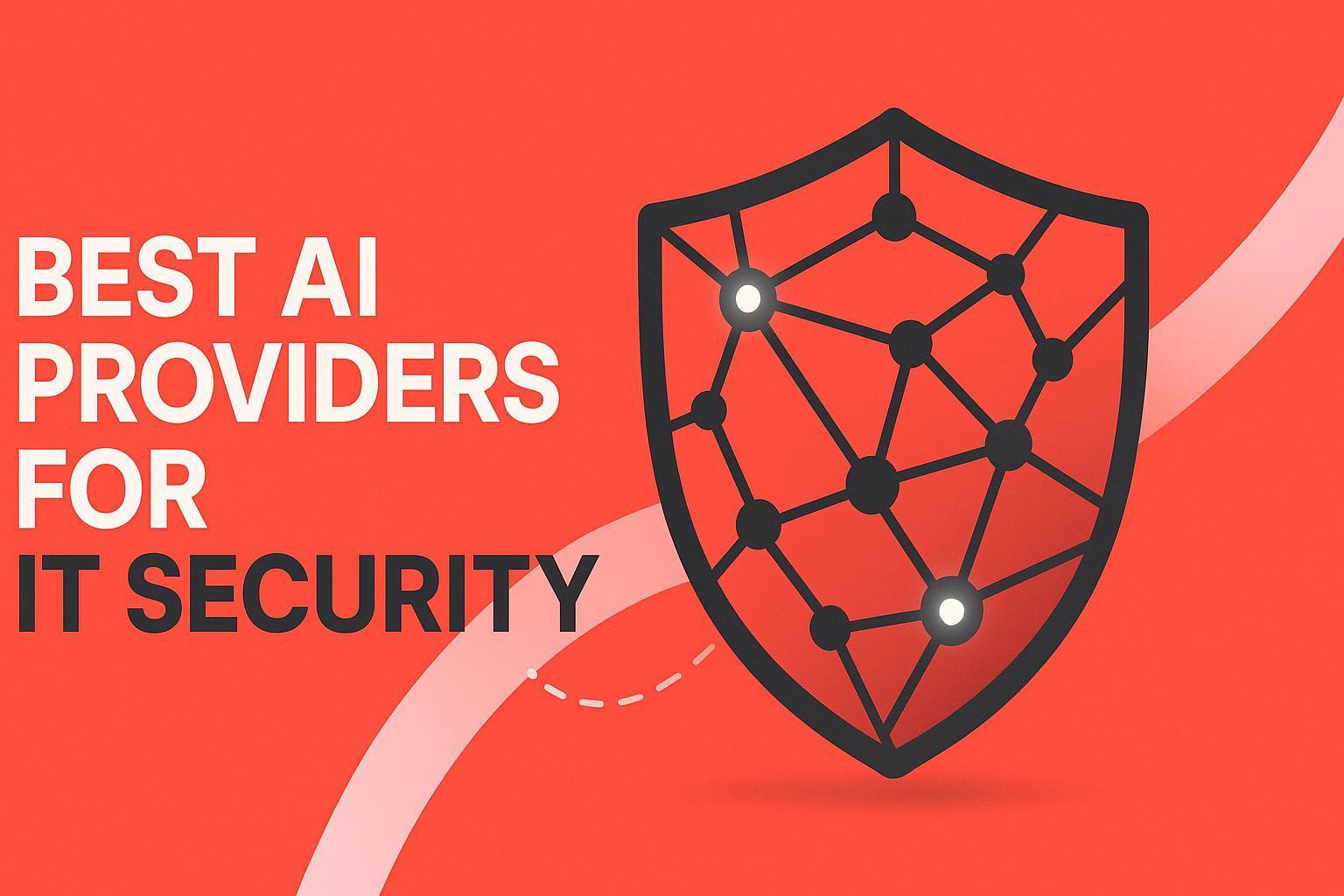
.jpg)

.jpg)